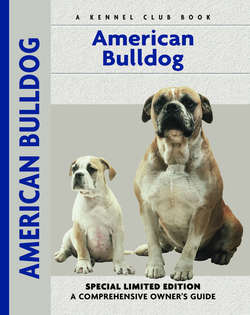Читать книгу American Bulldog - Abe Fishman - Страница 8
На сайте Литреса книга снята с продажи.
MODERN LINES OF AMERICAN BULLDOGS
ОглавлениеWhen the American rare-breed fancy discovered the American Bulldog in about 1982, there were three breeders who were best known for their involvement in the breed. Today we think of primarily two but sometimes all three of them as being the fathers of distinct “lines” of modern American Bulldogs. One of these men was Joe Painter of Chicago, Illinois. Painter was widely thought to have been interested in breeding primarily fighting dogs, and his American Bulldogs were generally thought to have been crosses between American Bulldogs and highly game-bred American Pit Bull Terriers from the Chicago area.
This dog possesses many typical breed characteristics: mostly white, black nose and impressive head.
The second of these men was Alan Scott of Alabama. Scott was a young man in 1982 and could not have been involved in Bulldogs for very long. At the time, the American Bulldogs he owned and produced were pure working-type Bulldogs of the type that had been around for many decades. Scott turned his interests away from American Bulldog breeding for a few years, and it was only during the mid-1990s that he returned to it, using the stock that was available to him then.
This dog’s undershot jaw is typical of many American Bulldogs today but would not have been functional for the early working catch dogs.
America in the 1980s saw the development of several distinct lines of American Bulldogs that greatly influenced the dogs we see today.
The third of these men was one John D. Johnson of the state of Georgia. Johnson’s Bulldogs had been essentially the same as Scott’s prior to the late 1970s. More than any other breeder then or since, Johnson responded to the novice puppy purchasers’ demands for oversized, “bully-looking” dogs. Seemingly overnight, “Johnson dogs” grew dramatically in size. Whereas in 1980 and before, Johnson’s big dogs weighed no more than 80 or 85 pounds, by 1985 Johnson was advertising Bulldogs that weighed as much as 135 pounds. The appearance of the dogs changed just as dramatically.
Although the “lines” of American Bulldog are relatively new, this is by no means a new breed.
There are many rumors about the many breeds with which Johnson crossed his Bulldogs in order to achieve the size and the entirely new look. Rather than speculate here, let us pass on the following information. At the core of Johnson’s bloodlines from about 1980 on is a bitch by the name of Bullmede’s Queen. Queen was bred and owned by Mr. Dave Leavitt, then of Spring Grove, Pennsylvania. Leavitt was very honest about the breeding techniques he used in his own production of dogs; he intended to recreate the “Olde English Bulldogge,” theoretically the Bulldog in its original form. An examination of Leavitt’s bloodlines will clearly demonstrate that Queen, an important bitch in Johnson’s breeding of American Bulldogs, was in fact part Pit Bull, part show-variety English Bulldog and part Bullmastiff. The reader can speculate along with so many others regarding what else Johnson may have crossed into his “American Bulldog” lines from that point on. What we do know for sure is that his dogs became so different from all other American Bulldogs that many no longer consider his dogs to be of the same breed.
We must understand this if we are to find a proper Bulldog for ourselves and to attempt to preserve the true American Bulldog for dog owners in years to come. It is not an American Bulldog out of any one of these lines, or an American Bulldog out of a conglomeration of these lines, that will be the best American Bulldog. It is a Bulldog of old working lines that will be the true American Bulldog.
THE OLD AND THE NEW
The three lines mentioned here, and all other lines you will hear reference to, are newly created lines, but the American Bulldog is by no means a newly created breed. This is a very old working breed that has been very adversely impacted by cross-breeding in recent years. This breed was essentially pure-bred before any of the men whose names are connected to the various lines were born. It remained in a very homogeneous form for many decades, and it was only when we began to think in terms of “lines” that the breed became as thoroughly genetically diluted as it is today.
